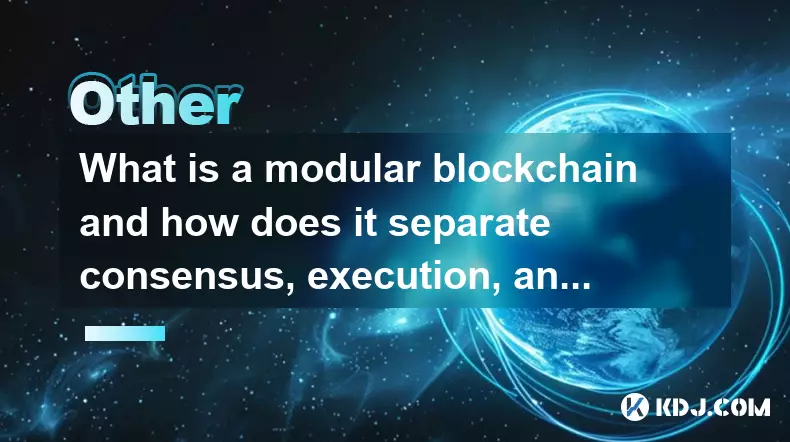-
 bitcoin
bitcoin $103128.103252 USD
-3.33% -
 ethereum
ethereum $3437.127692 USD
-4.86% -
 tether
tether $0.999700 USD
-0.02% -
 xrp
xrp $2.403993 USD
-5.73% -
 bnb
bnb $961.374676 USD
-4.11% -
 solana
solana $154.938665 USD
-8.18% -
 usd-coin
usd-coin $1.000113 USD
0.03% -
 tron
tron $0.298122 USD
0.30% -
 dogecoin
dogecoin $0.172428 USD
-5.76% -
 cardano
cardano $0.557625 USD
-7.13% -
 hyperliquid
hyperliquid $38.740701 USD
-6.51% -
 chainlink
chainlink $15.306051 USD
-7.51% -
 bitcoin-cash
bitcoin-cash $507.558648 USD
-3.26% -
 stellar
stellar $0.281899 USD
-6.74% -
 unus-sed-leo
unus-sed-leo $9.241811 USD
0.57%
What is a modular blockchain and how does it separate consensus, execution, and data?
Modular blockchains split core functions like consensus, execution, and data availability into specialized layers, boosting scalability, security, and innovation across decentralized networks.
Nov 11, 2025 at 10:19 pm

Understanding Modular Blockchain Architecture
1. A modular blockchain is a design approach that breaks down the core functions of a blockchain into distinct, interoperable layers. Unlike traditional monolithic blockchains like Bitcoin or Ethereum, where all operations occur on a single chain, modular systems assign specific tasks to specialized components. This separation enhances scalability, flexibility, and efficiency across the network.
2. The primary functions typically decoupled in a modular setup are consensus, execution, and data availability. Each of these components can be optimized independently, allowing developers to upgrade or replace one layer without disrupting the entire system. This modularity supports innovation and faster iteration cycles within the ecosystem.
3. By isolating functionality, modular blockchains enable rollups and other scaling solutions to operate more efficiently. Instead of forcing every node to process every transaction, the workload is distributed. Execution happens off-chain, while consensus and data verification remain secured by the base layer.
4. This architecture allows for greater customization. Different applications can choose their preferred execution environment while still relying on a shared, secure consensus mechanism. Projects such as Celestia, EigenLayer, and Arbitrum exemplify various implementations of this model.
5. Modular designs reduce bottlenecks by enabling parallel processing and targeted upgrades, making them ideal for high-throughput decentralized applications.
Decoupling Consensus from Execution
1. In a monolithic blockchain, nodes both validate transactions (execution) and agree on the state (consensus). This tight coupling limits performance because every node must replicate all work. Modular blockchains separate these roles: some nodes handle transaction processing, while others focus solely on validating the order and correctness of blocks.
2. Execution environments, such as optimistic or zk-rollups, process transactions independently and submit results to a consensus layer. The base chain does not execute the transactions but ensures that the proposed state transitions follow the rules. This reduces computational load on the main network.
3. Rollup operators batch hundreds of transactions off-chain and post compressed proofs or summaries to the consensus layer. Validators on the base layer verify these inputs without re-executing them, drastically improving throughput and lowering fees.
4. This division allows execution layers to innovate freely—using different virtual machines or programming languages—while inheriting security from the underlying consensus mechanism.
5. For example, Ethereum serves as a consensus and data availability layer for many rollups, which handle execution. This setup leverages Ethereum’s decentralization and security while delegating computation to more efficient systems.
Isolating Data Availability
1. Data availability refers to the assurance that transaction data is published and accessible for verification. In modular blockchains, this function is often separated from both consensus and execution. Without guaranteed data availability, validators cannot audit state transitions, opening the door to censorship or fraud.
2. Some networks use data availability sampling (DAS), where light clients randomly sample parts of a block to confirm its availability without downloading the full dataset. This technique scales validation across thousands of nodes efficiently, even with limited bandwidth.
3. Dedicated data availability layers, like Celestia, publish raw transaction data and allow independent execution engines to pull from it. These layers do not process transactions themselves but ensure that all necessary information is publicly stored and retrievable.
4. When rollups post transaction data to a data availability layer, they enable trustless bridging and fraud detection. Anyone can reconstruct the state if needed, preserving decentralization and transparency.
5. By externalizing data availability, modular chains prevent centralization risks associated with opaque or restricted data access, reinforcing user sovereignty.
Frequently Asked Questions
What problem does modular blockchain solve?Modular blockchains address scalability and inflexibility in traditional systems. By splitting responsibilities across layers, they allow higher transaction throughput, lower costs, and easier upgrades compared to monolithic designs that bottleneck at the chain level.
How do rollups benefit from modular architecture?Rollups leverage modular blockchains by offloading execution while relying on the base layer for consensus and data availability. This enables faster processing and reduced gas fees, with security maintained through cryptographic proofs and decentralized verification.
Can a modular blockchain be less secure than a monolithic one?Security depends on implementation. If the consensus and data availability layers are robust and decentralized, modular systems can be equally or more secure. However, reliance on external layers introduces new trust assumptions that must be carefully managed through economic incentives and cryptography.
Which projects are leading in modular blockchain development?Celestia focuses on data availability, Ethereum acts as a settlement and consensus layer for rollups, and EigenLayer enables restaking for securing modular components. Together, these projects form the foundation of the emerging modular stack in crypto infrastructure.
Disclaimer:info@kdj.com
The information provided is not trading advice. kdj.com does not assume any responsibility for any investments made based on the information provided in this article. Cryptocurrencies are highly volatile and it is highly recommended that you invest with caution after thorough research!
If you believe that the content used on this website infringes your copyright, please contact us immediately (info@kdj.com) and we will delete it promptly.
- XRP ETF Approved, Bitcoin Stabilizes, Crypto Updates: What's Next?
- 2025-11-12 19:00:00
- Evercade Alpha Taito Edition: Bartop Behemoth or Redundant Retro?
- 2025-11-12 19:15:02
- Zcash in 2025: Buy, Hodl, or Bye-Bye?
- 2025-11-12 19:00:02
- XRP Tundra's Audited Presale: Riding the Wave of Transparency in Crypto
- 2025-11-12 19:00:02
- MEXC, Chiliz, CHZ Frenzy: A Million-Dollar Fan Fiesta!
- 2025-11-12 19:05:01
- Visa, Stablecoin, and USDC: A New Era of Payments?
- 2025-11-12 19:40:01
Related knowledge

What are intents in crypto and how do they change user interaction?
Nov 09,2025 at 09:00am
Understanding the Role of Decentralized Exchanges in Modern Crypto Trading1. Decentralized exchanges, commonly known as DEXs, have reshaped how trader...

What is restaking and how does it enhance economic security?
Nov 09,2025 at 11:40pm
Understanding Restaking in the Blockchain Ecosystem1. Restaking refers to the process where users who have already staked their tokens in a proof-of-s...

What is a sovereign rollup and how does it differ from a smart contract rollup?
Nov 10,2025 at 09:00am
Understanding Sovereign Rollups1. A sovereign rollup operates as an independent blockchain layer that leverages the data availability of a base layer,...

What is a crypto-economic system and how does it use incentives to secure a network?
Nov 11,2025 at 01:20am
Understanding Crypto-Economic Systems1. A crypto-economic system refers to the integration of cryptography, distributed systems, and economic incentiv...

What is a blockchain's throughput and how is it measured?
Nov 12,2025 at 04:00am
Understanding Blockchain Throughput1. Blockchain throughput refers to the number of transactions a blockchain network can process within a specific ti...

What is the difference between a simple payment verification (SPV) node and a full node?
Nov 12,2025 at 09:40am
Understanding the Role of Full Nodes in the Blockchain Ecosystem1. A full node downloads and verifies every block and transaction in the blockchain ac...

What are intents in crypto and how do they change user interaction?
Nov 09,2025 at 09:00am
Understanding the Role of Decentralized Exchanges in Modern Crypto Trading1. Decentralized exchanges, commonly known as DEXs, have reshaped how trader...

What is restaking and how does it enhance economic security?
Nov 09,2025 at 11:40pm
Understanding Restaking in the Blockchain Ecosystem1. Restaking refers to the process where users who have already staked their tokens in a proof-of-s...

What is a sovereign rollup and how does it differ from a smart contract rollup?
Nov 10,2025 at 09:00am
Understanding Sovereign Rollups1. A sovereign rollup operates as an independent blockchain layer that leverages the data availability of a base layer,...

What is a crypto-economic system and how does it use incentives to secure a network?
Nov 11,2025 at 01:20am
Understanding Crypto-Economic Systems1. A crypto-economic system refers to the integration of cryptography, distributed systems, and economic incentiv...

What is a blockchain's throughput and how is it measured?
Nov 12,2025 at 04:00am
Understanding Blockchain Throughput1. Blockchain throughput refers to the number of transactions a blockchain network can process within a specific ti...

What is the difference between a simple payment verification (SPV) node and a full node?
Nov 12,2025 at 09:40am
Understanding the Role of Full Nodes in the Blockchain Ecosystem1. A full node downloads and verifies every block and transaction in the blockchain ac...
See all articles


























![[4K 60fps] no care by crashpancake2 (1 Coin) [4K 60fps] no care by crashpancake2 (1 Coin)](/uploads/2025/11/12/cryptocurrencies-news/videos/6913a8862890b_image_500_375.webp)















































